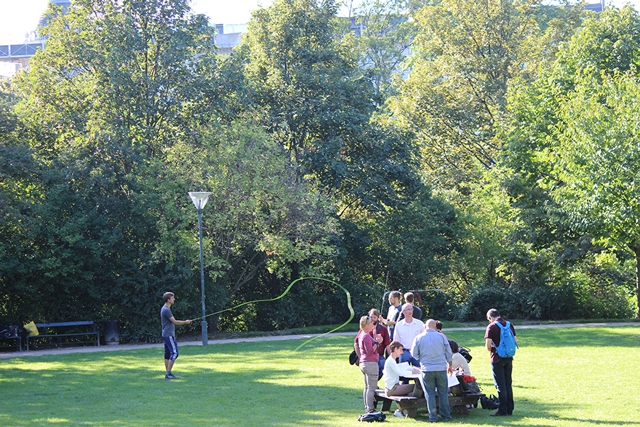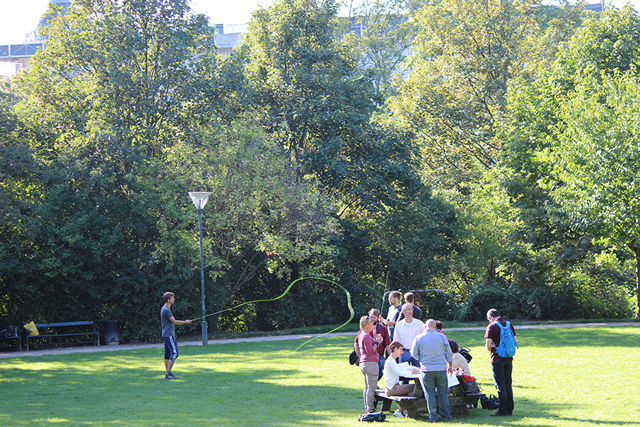
Study tour gets street-level view of how Copenhagen reinvented itself
A cyclist rides through downtown Copenhagen. Photographer: Torbörn Larsson/Knight Foundation
Riding bikes through an unfamiliar city may be the easy part. Taking home lessons learned will take skill.
The tour, organized by 8-80 Cities and supported by Knight Foundation, will also cross the Oresund Bridge to Malmö, Sweden, a port city that reinvented itself as a hi-tech hub after losing its shipbuilding industry in the 1990s, winning back double the 50,000 jobs it lost.Thirty-four city officials and community leaders from nine U.S. cities have embarked on a five-day study tour of Copenhagen, Denmark, considered one of the world’s most livable cities for its pedestrian-friendly downtown, network of bike trails, ubiquitous urban green spaces and abundant public transportation.
The participants include mayors, city council members, urban planners, engineers, leaders of community organizations and more from Akron, Ohio; Charlotte, N.C., Columbus, Ga.; Detroit; Lexington, Ky.; Macon, Ga.; Miami; San Jose, Calif., and St. Paul, Minn. They are viewed as civic innovators for leading potentially high-impact work in their communities, all cities where John S. and James L. Knight once owned newspapers. Knight Foundation and 8-80 Cities staff are also on the tour. 8-80 is dedicated to helping make cities livable for people from 8 to 80 by promoting walking, biking and public transit.

Jeff Risom of Gehl Architects leads a master class during the livable cities tour. Photographer Torbjörn Larsson/Knight Foundation
The how—and why—of livable cities
The group set out to study the city on Sunday the same way more than half of Copenhagen’s 500,000 residents commute to work daily: by bicycle. They attended a master class led by Jeff Risom of Gehl Architects on designing cities for people, explored an eclectically charming neighborhood park carved out between apartment buildings, and watched “The Human Scale,” a documentary about how warm, social cities—instead of bleak, impersonal megacities—can be humanity’s future.

RELATED LINK
“Want to build a bikeable city? Focus on those who don’t bike” by Andrew Sherry on Knight Blog (10/10/14)
“The first rule of livable cities: pedestrians first” by Andrew Sherry on Knight Blog (10/08/14)
“Creating a more connected Charlotte, N.C.” by Susan Patterson (09/09/14)
“Does placemaking help democracy?” by Andrew Sherry on Knight blog (08/29/14)
“Study tour gets street-level view of how Copenhagen reinvented itself”by Andrew Sherry on Knight blog (08/25/14)
“‘Knight Cities’- A conversation with Gil Penalosa on building better communities” by Carol Coletta on Knight blog (08//20/14)
“Teams from Knight communities to travel Scandinavia on livable cities tour” by Carol Coletta on Knight blog (07/25/14)
The basic playbook for livable cities is largely written. Put people first. Design for pedestrians, followed by cyclists and public transit. Make all three modes comfortable, affordable, efficient and accessible, to give people choices. Even on the first day, participants saw details of how that strategy plays out in Copenhagen, such as sidewalks and bike lanes that remain slightly elevated as they cross intersections, reminding cars to slow down.
But what was clear, even on the first day, is that the why of livable cities is just as important as the how. Encouraging bikes and eliminating downtown parking is not the default policy position in American cities such as, say, Detroit. 8-80 Cities Executive Director Gil Penalosa says he often hears from Americans, “Yes, but Copenhagen is different.”
Not that different
In fact, Copenhagen has much in common with America’s post-industrial cities; it just started to reinvent itself sooner. Copenhagen embraced the car fervently in the ’50s and’60s. The huge public squares of the center city were parking lots. The walking streets now lined with shops and thronged by pedestrians were clogged with cars. The suburbs were expanding and roads were seeing an ever-growing crush of commuters. As heavy industry evaporated, much of the city went from industrial to blighted.
Increasing the livability of downtown was one part of the city’s recovery. By attracting residents, including young families, it has dramatically improved the city’s tax base, generating funds for new projects. But for city planners, there is another imperative: The population of greater Copenhagen continues to grow, and the city simply cannot accommodate several hundred thousand more cars daily.
Demographics may be a powerful motivator for many cities in the United States, where the population is projected to grow by 100 million over the next 30 years. Or it may be the fact that more than 30,000 bicyclists and pedestrians die in traffic every year in the United States. Or it may be simply about attracting and retaining talent to be more competitive. Regardless, Gehl’s case studies from around the world highlighted the need for a sense of urgency for transformative projects.
“Everything is first priority until you leave the room,” said Meg Daly, chairman of Miami’s Friends of the Greenlink, describing working with supportive yet harried local officials. “We need a sense of urgency from the public to sustain the project.”
In the remaining four days, participants—several of whom attended 8-80’s “Doable City” conference in Chicago in June—will go deeper into the playbook for building livable cities that put people first. And with experience ranging from city hall to engineering to community advocacy, they will be exchanging ideas on how to bring the best of what they’ve learned back to their communities.
Andrew Sherry is vice president of communications at Knight Foundation.
Recent Content
-
Community Impactarticle ·
-
Community Impactarticle ·
-
Community Impactarticle ·


